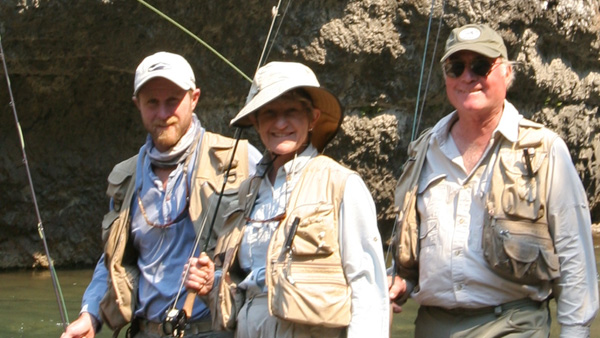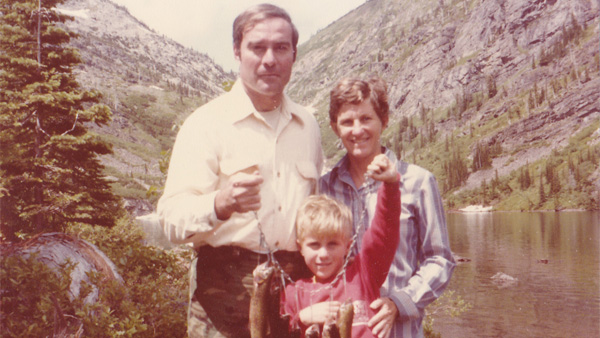A Father's Fishing Legacy
 © Terry Gibson
© Terry GibsonThe Gibson family -- Terry and his parents Bert and Sally -- in 2008 as they make an annual retreat away from the coastal fisheries they love to flyfish in the Clarks Fork of the Yellowstone drainage in Wyoming.
During the peak of the 2013 fall mullet run, I took my father fishing on the Indian River Lagoon in eastern Central Florida for the last time. Three months earlier, the 68-year-old sportsman was diagnosed with terminal brain and lung cancer, though he never smoked and led a vigorous physical and intellectual existence. I am happy that he got to fish the mullet run that last time. He died a few days before Thanksgiving.
Out of respect for how we had almost always fished together for 35 years, I’d rigged mullet patterns on 9-, 10- and 12-weight fly rods standing in rod holders along the center console of my 23-foot Bay Ranger. Dad was in no condition to balance on the front deck and cast a big fly with a stiff saltwater fly rod. Thankfully, he humbly went along with my suggestion that we fish with live bait instead of his favorite mullet imitations.
We ran north of the Jensen Beach Causeway and found a half-acre school of finger mullet rippling the surface. He grinned widely when I lifted up the cast net. It was so full of bright three-inch striped mullet that I worried it would tear. Dad loved the mullet run for the same reasons that so many outdoor enthusiasts do. In Florida, there’s no other natural event that is more exciting for a fisherman. It is a sublime spectacle of millions of baitfish pursued by every piscivorous predator with fins, feathers, or a blowhole. And that spectacle is reassuring in the face of so much bad news about the condition of the entire Indian River Lagoon complex, one of North America’s most biologically diverse coastal ecosystems.
 © Terry Gibson
© Terry GibsonTerry Gibson, age 7, in 1981 with his parents, Bert and Sally, holding a stringer of cutthroat trout caught during a wilderness camping and fishing expedition in Montana. The family traveled extensively across America and abroad to fish in remote waters.
Mullet are essential food for our favorite sport fish and act as a bellwether of the lagoon’s health. That net full of juveniles was a shining reminder that all is not yet lost for the lagoon, or for other Florida waters slipping toward collapse. It reminded me that maintaining strong populations of forage fish is a key element in protecting all of Florida’s waters from further ecological decline.
I staked out and drifted the finger mullet back toward some of my favorite mangrove points that are close to where we caught the bait. Dad’s energy was extremely limited, and I didn’t want to waste a lot of time running around. We picked up a few small jacks, and Dad missed a couple of snook. He hadn’t fished with live bait since he was a kid, except for a handful of times offshore. Accustomed to strip-striking fish swirling on flies, he was too quick on the draw for circle hooks. I really wanted him to get a snook—hands down his favorite saltwater species. But I didn’t know if we’d get another shot at one before he ran out of energy.
I made a quick run over to where the Nettles Island seawall makes a 90-degree turn and began training the baits to swim tight to the wall under a float. A 26-inch snook exploded on Dad’s finger mullet, and this time he connected. I have never wanted so badly for someone to land a fish. Fortunately, Dad and the circle hook did a good job staying connected. He was ecstatic and exhausted. Once I revived the fish, I knew it was time to go.
I will never forget that moment and am still struggling to grasp its full significance. As I watched the fish quickly disappear into the filthy water, the elation gave way suddenly to anger and fear arising from two sources of bereavement: Dad’s failing health and a horribly polluted estuary.
The water was dark brown and turbid and smelled like a ditch. Salinity levels were dangerously low while nitrogen levels were skyrocketing. That was because between early June and early November 2013, hundreds of billions of gallons of polluted runoff water was dumped into this estuary to control flooding.
In the northern and central Indian River Lagoon, algae blooms encouraged by a number of different pollution sources have killed most sea grass meadows. I wondered then, as I have many times since the sea grasses started rapidly disappearing, whether we’re fishing in a terminally ill estuary.
What makes my dad’s demise and the declining health of the Indian River Lagoon parallel is a dangerous human tendency to ignore obvious symptoms and carry right on toward disaster while hoping for the best. There’s a chance my dad would still be alive today if he had heeded the early warning signs of cancer and acted. But after it was too late, he was left with experimental treatments that didn’t work.
I’m really proud of the way people have stepped up for the lagoon, but a lot of the remedies under consideration for funding are also experimental. We Floridians should have seriously addressed the problems created by faulty septic tanks, fertilizers, and runoff decades ago, at the first signs of trouble.
But now we are running out of time. Whether you fish inshore, nearshore, or offshore, you should be concerned. Estuaries are the nurseries for many of our rock star species. Some spend their lives inshore, such as spotted sea trout. Others move offshore as young adults. Redfish and many groupers and snappers change habitat preferences and migrate offshore for all or part of the year. The same goes for the forage fish, such as pinfish, that our rock star species need to eat to grow and reproduce.
There is much reason for hope. We have witnessed other horribly polluted and heavily fished systems return to life once pollution problems were fixed. Tampa Bay and Sarasota Bay are great examples. I’ve spoken with a number of Indian River Lagoon experts, and they say if we can restore the water quality, we should see a return of the sea grasses that are so essential for fisheries production.
In the meantime, they warn us to keep a careful eye on fish populations, especially on forage fish such as mullet and pinfish. Those forage species are at a place in the food web where the breakdowns generally happen in a heavily fished ecosystem choking on pollution. If we want to maintain relatively high and stable populations of our favorite predator fish, as well as the birds and dolphins that we enjoy seeing on the water, then we need to maintain diverse forage species. We need strong individual populations with a healthy balance of varying age groups.
Since I felt the reality of my father’s death, I’ve realized the importance of passing on what he taught me about fishing. And with these crises, I’m fully realizing the importance of passing on vital information from scientists, with the hope of restoring health and energy to the waters my father so loved to fish.
Anglers for Conservation is one of the most determined and effective teams of outdoor educators in this country. I would like to thank the AFC board for allowing me to share this story, and for future opportunities to communicate what I’ve learned from experts about the ecological challenges the next generation of anglers will face. Here’s to a future filled with tight lines in clean waters teeming with fish.
About the author: Terry Gibson serves as a recreational fishing outreach consultant for The Pew Charitable Trusts in Florida. Gibson also serves as the Visit Florida boating and fishing insider and as senior editor of Fly & Light Tackle Angler magazine, where a copy of this article also was published. http://new.anglersforconservation.org/2014/06/03/a-fathers-fishing-legacy/
Sea Grass and Forage Fish
Mullet and other forage species such as pinfish are obviously a vital food source for the predatory fish we like to catch. They also help maintain important fish habitat critical to the health of the Indian River Lagoon and other Florida waters. Take, for instance, the ways mullet, pinfish, and sea grasses all depend upon one another. As early juveniles, mullet and pinfish go through a life stage where they are carnivorous, feasting on tiny crustaceans and other tiny animals found among the blades of sea grasses and on the algae that cover sea grass blades. These forage species need those sources of protein for a growth spurt that makes them less vulnerable to predators and more likely to make it to sexual maturity.
Then they undergo what’s called an ontogenetic shift where metamorphic changes to their stomachs, intestines, lips, and even teeth (in the case of pinfish) allow them to feed on detritus and algae, including the kinds of algae that attach to sea grass, known as algal epiphytes. Epiphytes occur naturally and provide cover for tiny organisms at low levels of the food webs, such as the crustaceans that really young mullet require. But the epiphytes can smother sea grasses if they are not grazed on by forage species such as adult mullet and pinfish.
In disturbed ecosystems such as the Indian River Lagoon, where we’ve added nitrogen in excess, the grazers become all the more essential to winning the battle against choking algae and ensuring that Florida’s sea grasses receive sufficient sunlight. Meanwhile, these forage species turn nutrients from the epiphytes into the fatty acids that predator fish and birds require in high volumes in order to grow and reproduce.
Therefore, maintaining sufficient abundance, variety, and sizes of mullet and other forage fish species is imperative if we are to restore sea grass beds and maintain strong numbers of snook, tarpon, redfish, speckled trout, and other recreationally important fish species for future generations of anglers.











